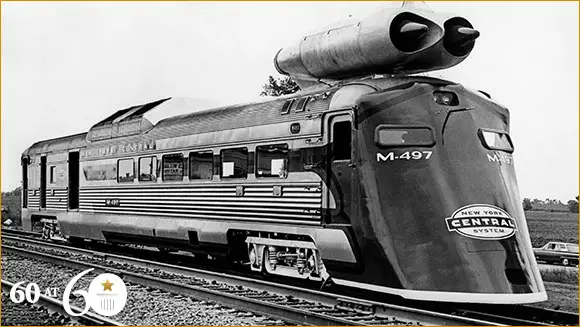
Fifty years ago, Don Wetzel was working for the New York Central Railroad as assistant director in the research department. Needless to say, he was dealing with the same key issues that concern his peers today: making trains run more efficiently. And more cheaply. And faster.
How could they engineer significantly faster speeds? Sometimes, the simplest solutions are the best, thought Don. So why not take a high-speed locomotive and then stick a couple of rocket boosters jet engines on to it?
To that end, he sourced a Budd Rail Diesel Car (RDC-3), then added a curved, more streamlined front section; the latter was designed by his wife, who worked as a commercial artist. For that all-important extra propulsion, Don paid the US Air Force $5,000 apiece for two surplus General Electric 5,000-hp J47-19 engines, formerly used as boosters for the Convair B-36 “Peacemaker” bomber aircraft; as well as being relatively affordable, they could also be adapted to run on diesel. In fact, the J47-19 engine had already made land-speed history three years earlier, on 5 August 1963, powering Craig Breedlove’s (USA) Spirit of America jet car to a then record speed of 407.518 mph (655.837 km/h) – making it the First car to exceed 400 mph over both legs of a two-leg run:
Don and his team put together the hybrid contraption at Collinwood Yard in Cleveland, Ohio, USA. They fixed the J47-19s to the top of the locomotive, at the front. Each booster would generate approximately 7,050 Newton-metres (5,200 pound-feet) of thrust.
That all sounds fine in principle. But would it work?
On 23 July 1966, Don – an ex-military pilot – put the machine to the test on a flat, straight stretch of railway between Butler, Indiana, and Stryker, Ohio. The results spoke for themselves: the Black Beetle reached a speed of 296 km/h (183 mph). Interviewed by GE Reports in February 2014, the then 82-year-old Don revealed that the train had gone even faster and was actually slowing down when it was timed: “On my second run our speed reached 196 mph [315 km/h] and we were decelerating when we went through the timing traps… Everybody thought that it was quite funny that we set a world record while decelerating.”
With the record in the bag, the boosters were removed from this unique vehicle and re-employed on snow blowers. The Black Beetle never went into production and remained an experimental one-off. But that day in 1966 proved conclusively that high-speed rail travel was possible using existing technology.
